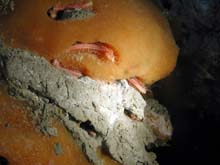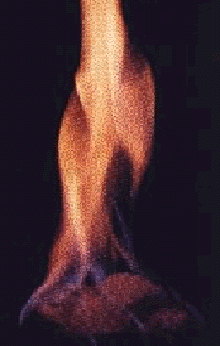
This orange gas hydrate is home to Hesiocaeca methanicola, a newly discovered species of marine worm found in the Gulf of Mexico in 1997. This lobe of hydrate was exposed on the sea floor. We will investigate the life in a shallow bed above this hydrate on Blake Ridge. Click image for larger view.
Burning Ice in the Cold, Deep Biosphere
September 23, 2001
Paula Keener-Chavis, Director
South Carolina Statewide Systemic Initiative's Charleston Math and Science Hub
Deep East Education Project Coordinator
I could never stay long enough on the shore. The tang of the untainted, fresh and free sea air was like a cool, quieting thought, and the shells and pebbles and the seaweed with tiny living creatures attached to it never lost their fascination for me.
--Helen Keller
The research vessel (R/V) Atlantis and its crew continue on their way to Blake Ridge, a geologically stable area that was rifted so long ago that it contains some of the oldest existing oceanic crust. The crust is estimated to be approximately 180 million yrs old. Blake Ridge is the result of sediments deposited at the intersection of two swiftly moving currents, the North Atlantic Bottom Water Current and the Antarctic Bottom Water Current. The sea floor is steep, and these currents hug the edges of the continental slope. The area is also pervasively faulted, and scientists are still puzzling over why the faults are here and how they have persisted over eons.

Bathymetry of the Blake Ridge dive area, including the site of ODP hole 996 at the edge of a salt diapir. Click image for larger view.
Gas and Salt 'Mines'
The dive site was drilled in 1995 as part of the United States' ocean drilling program, and is known to be an area of focused fluid and gas emissions from the deep-sea floor. The source of these emissions is gas hydrate deposits in the sediments. Gas hydrates are an icelike form of methane and water that is stable at pressure and temperature conditions common in deep-sea sediments.
Gas hydrates have received a great deal of attention in the past decade both as a potential source of energy and their possible connection with global climate change. Additionally, gas hydrates are believed to contribute to large-scale submarine slides. In fact, scientists believe that gas hydrates may have been connected to the development of the Cape Fear Slide, the largest slide ever known to occur on the eastern U.S. continental slope.
An interesting feature at the dive site is a large salt diapir, a subsurface salt formation that has protruded through the sediments, thus perturbing the gas-hydrate system. The concentration of heat above the diapir causes the gas hydrate to break down and release methane gas. This gas escapes from the sea-floor sediments through various pathways, and, as a result, is available to feed a chemosynthetic community (as opposed to photosynthetic communities, which rely on light for energy) near the source of the emissions.
When the deep submergence vehicle Alvin makes its first dive of Leg 3 of the Deep East Expedition, scientists will be very interested to get a glimpse of the biodiversity associated with chemosynthetic communities found in proximity to these emission sites.

The icy nodules of gas hydrate burn. In Blake Ridge hydrates, the natural gas locked inside is mostly methane.
Interview with Mary Turnipseed
Second-year Graduate Student
Biology Program
The College of William and Mary
Ocean Explorer Team: What are your responsibilities on the Deep East Expedition?
Mary Turnipseed: I'm assisting one of the other graduate students in collecting mussel-pot samples and other sampling logistics related to the expedition. Based on my research at the Florida Escarpment cold-seep community, I will be able to note the similarities between the mussel-bed community at Blake Ridge and the cold-seep beds in Florida.
Ocean Explorer Team: As a second-yr graduate student, what is your perspective of the expedition?
Mary Turnipseed: This is my third cruise as a graduate student. I find it amazing that I 've had the opportunity to work with Alvin during these cruises. I'm also very lucky to work with my advisor, Dr. Cindy Lee Van Dover, who is well funded and can extend these incredible field opportunities to her graduate students as a result. When I heard about NOAA's Ocean Exploration program, I was very encouraged. The exploration of our ocean planet is paramount. Ocean exploration allows us to learn more about the vast reaches of the mid-ocean ridges that have yet to be observed. Knowledge of deep-sea biodiversity is so limited. With the increase in interest in deep-sea fisheries and exploration for oil, we could lose precious opportunities to know which organisms exist out there and how they contribute to the patterns of biodiversity. When one considers basic ocean research, nothing is more important than exploration.
Ocean Explorer Team: What and/or who influenced your decision to study ocean science?
Mary Turnipseed: At the age of 13, I became a certified scuba diver. I've been interested in marine biology ever since.
Ocean Explorer Team: What do you hope to do when you finish graduate school?
Mary Turnipseed: I need to sort out whether I want to stay in basic marine science or pursue a career in marine conservation policy.
Sign up for the Ocean Explorer E-mail Update List.
































